
|
First Docks For most of Cleveland's history, ship docks were located around the mouth of the Cuyahoga River. The lake shore east of West 9th Street was little more than a narrow beach strewn with driftwood. The Cleveland Yachting Club built the first tiny dock at what would later become the East 9th Street Pier. The group's clubhouse was built at the water's edge on the east side of what was then called Erie Street in 1895. That same year it was decided to extend Erie Street on a pier into the lake. From the end of this, a second pier extending west was built, creating a large basin between the lake and the shore. The basin was eventually filled which created fifty acres of new land, used for baseball fields and an extension of Lake View Park. By 1908 three large piers were built into the lake from this new land, two were owned by the city and another by the federal government. Unfortunately for the yacht club, the waters on the east side of the pier had become a garbage dump, a situation that would lead to the club's fracture and relocation in 1914. The Steamship Lines The Cleveland & Buffalo Transit Company (C&B) and the Detroit & Cleveland Navigation Company (D&C) were the two most important passenger steamship lines on Lake Erie in the nineteenth and early twentieth centuries. The comfortable and luxurious side wheel steamships "State of Ohio", "State of New York", "City of Buffalo", and "City of Erie" traveled from Cleveland to Detroit, Erie, Buffalo, Toledo, even Chicago, Illinois and Port Stanley, Canada. Smaller ships provided popular overnight excursions (known as "moonlight rides") to Cedar Point and Put-in-Bay. In November 1912 the extravagant new flagship of the C&B line was launched in Wyandotte, Michigan. Christened "Seeandbee," it was 500 feet long, 98 feet wide, boasted four decks, 510 staterooms and parlors finished in mahogany and ivory, a grand ballroom, and accommodations for 1500 passengers. It was the largest and most expensive passenger steamship to operate on the Great Lakes up to that time, a title it would retain until topped by the D&C line's "Greater Detroit" and "Greater Buffalo" in 1924. The "Seeandbee" entered regular service on the Cleveland - Buffalo route in June 1913. Up to this time the passenger steamships had docked in the Cuyahoga River near the Superior Viaduct. The docks were crowded, smokey, dirty, and generally unattractive. Moving the passenger docks to East 9th Street was first suggested in 1903. It was reasoned that arriving passengers would get a much better inital impression of the city, while the river docks could be used solely for freight. This would also place the passenger docks in close proximity to the union railroad station which was expected to be built at the lake shore as part of the "group plan." The dock then in place at East 9th Street, however, was deemed far too small and narrow for use by large steamships, and the plan was abandoned. The situation changed considerably over the next ten years, as the lake front land was filled in and large city docks constructed. In 1913 the two passenger steamship companies secured a 50 year lease on the city docks at East 9th Street, finally freeing them of the confines and traffic of the river. The steamship lines paid $55,000, agreed to build their own terminals, while the city agreed to build a bridge to carry East 9th Street over the Lake Shore & Michigan Southern Railroad tracks and extend streetcar service to the pier. The C&B line began using its new terminal on June 6, 1915, and Cleveland Railway service to the pier commenced three days later on June 9. The Railways The streetcar tracks made a large double-track loop on the west side of East 9th Street in front of the steamship terminals. Traffic flowed easily as streetcars came and went, and passengers streamed between the cars and the steamships. Harry Christiansen wrote, "I recall well when the pier was crowded with humanity, the trolleys and interurbans disgorging passengers toting suitcases, the mournful boat whistles, and the endless line of taxis on the hill." When the shipping season was over, usually November to May, streetcar service was cut back to only two cars a day: one in the morning to deliver employees to the steamship company offices, and another in the evening to pick them up. Lake Shore cars could be chartered to the pier for business and group outings of the kind the LSE aggressively solicited. Another popular promotion the LSE participated in was the honeymoon cruises. Harry Christiansen again wrote, "Through tickets were sold from LSE points to Niagara Falls via the LSE, Cleveland & Buffalo boat line, and the International Railway from Buffalo to the fall's brink. Newlyweds were offered a 12-day fiesta at 70 per cent off the round trip fare. Couples were deposited within sight of the gangplank at E. 9th Street Pier in Cleveland for the overnight boat run." The most frequent use of the pier by interurbans, however, was as a layover track for limited and express cars This was especially true of the Michigan interurban cars. Between departures from the Public Square station, coaches would layover at either West 3rd Street, the Eagle Ave. freight terminal, or the pier, depending on circumstances. Great Lakes Exposition During the summer of 1936 and 1937 Clevelanders were given a spectacular respite from the bleakness of the Great Depression. The Great Lakes Exposition, celebrating the centennial of Cleveland's incorporation, past achievements and future progress, covered 135 acres of the Cleveland waterfront from West 3rd Street to East 20th Street. One of the main entrances was located near the East 9th Street pier. Although the Lake Shore Electric had been in receivership since 1933, a great effort was put forth offering frequent service to and from the expo. An advertising blitz in newspapers and on radio encouraged the public to forego the hassles of city traffic and parking and ride the interurban to the expo instead. A coach was kept overnight at the station in Lorain to provide early morning limited service to Cleveland for expo patrons. By the end of summer 1937, over seven million people had attended the expo. No doubt the LSE was happy to have the temporary increase in revenue, but it was not enough to counter to loss of freight service earlier in the year which had already sealed the railway's fate. Decline Of Transportation On May 1, 1938, all LSE layovers were moved to the East 9th Street pier as demolition of the Eagle Ave. freight houses began. On May 14, a cool and rainy Saturday, the last LSE layovers rolled away from the pier, never to return. Cleveland Railway service to the pier ended on October 3, 1938, as the bridge to the pier was closed for construction on the Lakefront Highway, later renamed the Memorial Shoreway. The steamships experienced a decline similar to that of the interurbans. The depression caused such a precipitous loss of business between 1929 and 1932 that the famous "Seeandbee" was taken out of service for the 1932 season. Strikingly similar to the LSE, the C&B line filed for bankruptcy in 1937, reorganized, and struggled on. The fatal blow came on March 20, 1938 when the steamship "City of Buffalo" was destroyed by a fire while docked at the pier. The company was dissolved in 1939 and its assets liquidated. The "Seeandbee" was leased to the Cleveland & Buffalo Steamship Company of Chicago where it continued passenger service for another three years. In 1942 the US Navy acquired both the "Seeandbee" and the D&C line's "Greater Buffalo," converted them to aircraft carrier trainers, and renamed them USS Wolverine and USS Sable respectively. In 1947, their wartime usefulness over, both were sold for scrap. The D&C line survived the depression and experienced a resurgence during the gasoline rationing of WWII. Revenues fell again after the war and the D&C finally went out of business in 1951. When the C&B shut down in 1939 the lease on the East 9th Street pier was transferred to the Lederer Terminals Warehouse Company, for use as a freight dock. By the late 60's, the docks were again city property, but crumbling badly. The terminal buildings were demolished in 1970 and the pier was declared unsafe. North Coast Harbor In 1985 the non-profit agency North Coast Harbor, Inc. was organized to plan and manage redevelopment of Cleveland's lakefront property, including the East 9th Street pier. Since then the area has undergone major changes and is now a recreational and tourist destination, home to the Rock and Roll Hall of Fame and Museum, Great Lakes Science Center, Steamship William G. Mather Museum, Voinovich Park, USS Cod submarine, Cleveland Coast Guard station, and the "Goodtime III" cruise ship (spiritual successor to the C&B line's original "Goodtime" excursion ship of 1924). Burke Lakefront Airport and Cleveland Browns Stadium are also nearby. With the original steamship docks long since demolished, it can be difficult to reconcile the present structures with the busy rail and steamship traffic of nearly a century past. In fact, the Rock and Roll Hall of Fame Museum sits directly over the site of the streetcar loop. But in a city like Cleveland, which continues to reinvent itself, and especially on the shores of Lake Erie, change is the only constant. |
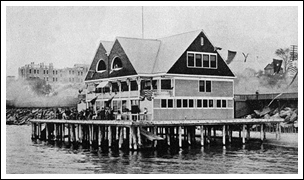
foot of East 9th Street (then called Erie Street) in 1895. (The Cleveland Cicerone) |
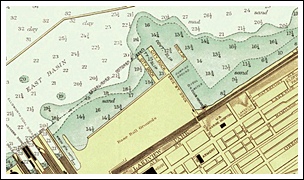
arrangement of the time. (railsandtrails.com) |
|
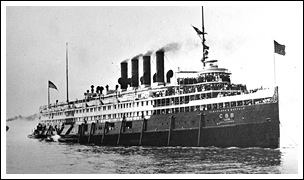
(Hayes Presidential Center) |
|
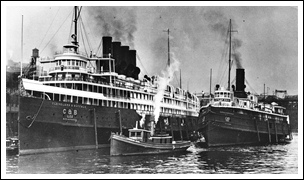
River, 1913. Note the streetcars on the Superior Viaduct in the background. (Hayes Presidential Center) |
|
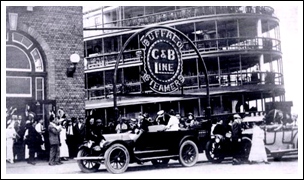
passenger terminal, with Seeandbee in its new slip. (Bowling Green State University) |
|
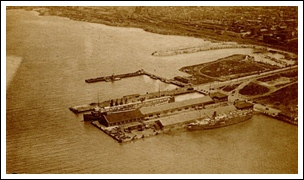
(Cleveland State University) |
|
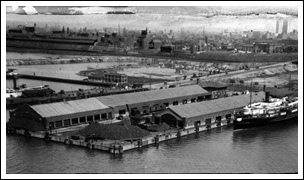
railroad tracks can be seen in background. (Cleveland Press) |
|
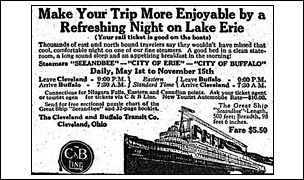
(Ohio Historical Society) |
|
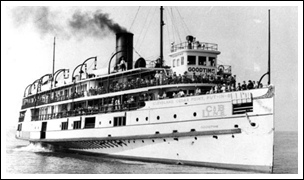
trips to Cedar Point and Put-in-Bay. (Cleveland State University) |
|
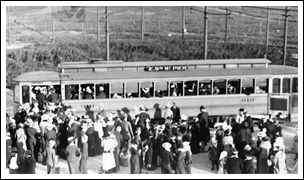
streetcar at the pier. (Dennis Lamont) |
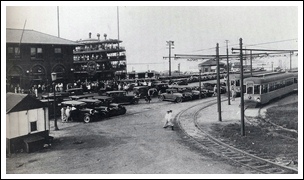
Seeandbee at the pier in 1929. (Jim Spangler) |
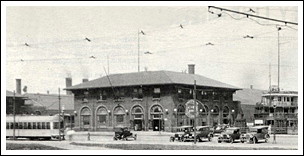
streetcar and the steamship City of Erie. (Harry Christiansen) |
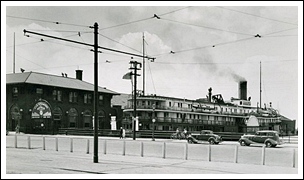
the streetcar loop. (Ohio Historical Society) |
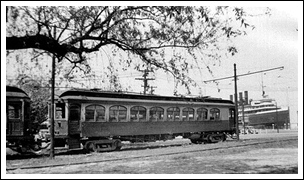
steamer Seeandbee in background. (Bill Volkmer) |
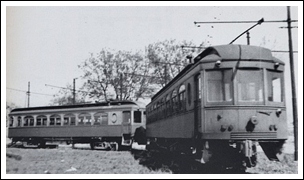
(Dennis Lamont) |
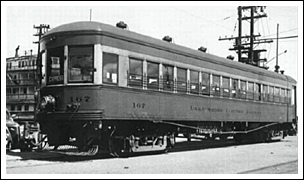
an express run in the 1930's. (Dennis Lamont) |
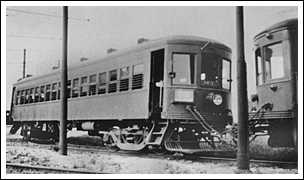
|
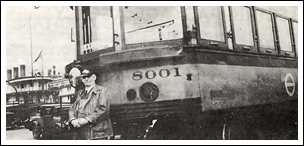
before making an express run back to Detroit. (Harry Christiansen) |
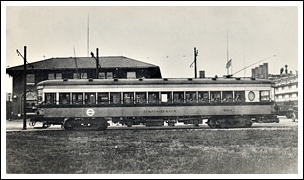
Sign in window is a notice that the railway is ending service. (Drew Penfield) |
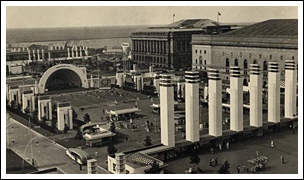
signature lighted pylons. (Cleveland State University) |
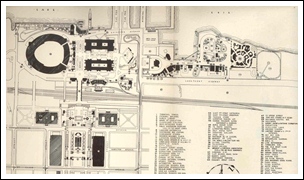
route on East 9th Street and the loop at the pier. (Cleveland State University) |
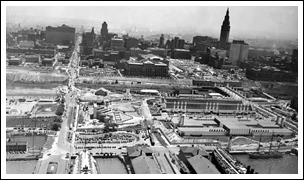
the pier. (Cleveland State University) |
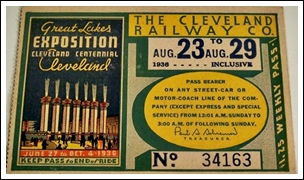
Lakes Expo. (Drew Penfield) |

(Harry Christiansen) |
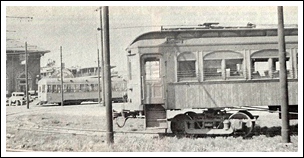
streetcar uses the outside track in 1938. (Harry Christiansen) |
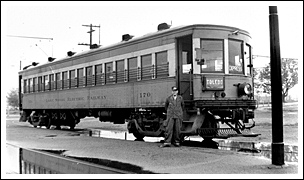
April 14, 1938. (Jim Spangler) |
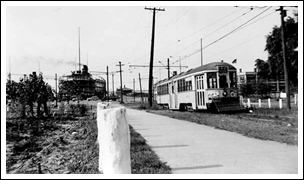
on October 3, 1938. (Cleveland State University) |
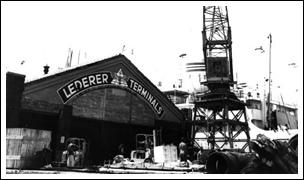
by the Lederer Terminal Warehouse Company. (Bowling Green State University) |
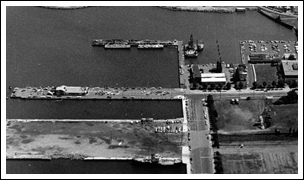
This 1974 photo shows the vacant pier and Frank's Lobster House. (Cleveland State University) |
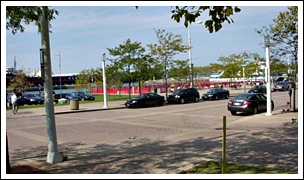
(Drew Penfield photo) |
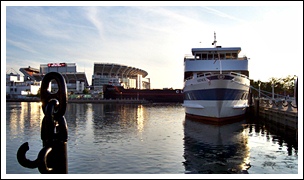
Steamship William G. Mather Museum, and the Goodtime III cruise ship. (Kristen Heider) |
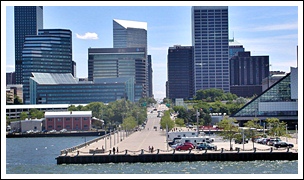
and Museum is at left. (Cleveland State University) |
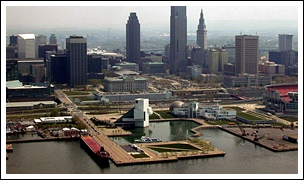
(Cleveland State University) |
|
|
|